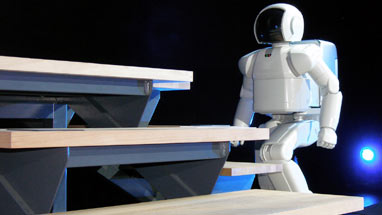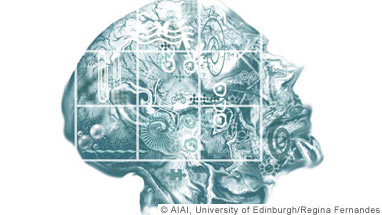Professor Austin Tate, Director of the Artificial
Intelligence Applications Institute (AIAI) at the University of Edinburgh,
discusses progress made in AI and what could be in store...

Professor Austin Tate
The field of artificial
intelligence (AI) has been characterised by some very optimistic projections,
coupled with an underestimation of the time and effort needed to produce
intelligence in machines. The impression many have of AI is gleaned from science
fiction where it may be portrayed in a human-like robot such as David in
Spielberg’s ‘A.I. Artificial Intelligence’, the crazed HAL in Kubrick’s ‘2001: A
Space Odyssey’, or super human (and often malevolent) entities such as Skynet in
Cameron’s ‘Terminator’ movies. Given such a fantasy portrayal it is not
surprising that reality may seem a little out of step with expectations.
I am an optimist and believe that AI methods (in particular
knowledge-based systems) will allow us to make much better use of information in
support of the tasks we wish to carry out, such that the processes involved will
be more transparent, open and explainable.
Professor Austin
Tate
Physical and reasoning aspects of robots both require much work.
Interacting with the world in a useful way is a big challenge. Though we are a
still a long way from realistic biped bodies with humanistic movement, great
strides have been made in this direction at a number of labs in the last decade.
A car has driven across the US ‘hands-free’ using sophisticated AI visual
processing and vehicle control software and the state of Nevada has now licensed
autonomous cars. In some US Grand Challenges, autonomous vehicles have driven at
high speed over rough terrain. Biped robot exoskeletons with AI adaptive systems
technology are becoming available and have assisted disabled people in walking
again.
The intelligence in an AI is normally in the software that runs on
a computer. There are many very clever, knowledgeable or intelligent programs
working on well-defined problem domains and helping people in their everyday
lives without them even being aware of it. However, brute force systems like the
core of IBM’s Deep Blue (the chess playing program/computer) do not strike me as
very intelligent. Rather, they are powerful and able to search many
possibilities in a short space of time. I would describe as more intelligent the
software on board the Deep Space 1 spacecraft that employed autonomous
intelligent planning and control software as it performed its mission.
In
terms of the synergy between increasingly capable computer systems and AI, AI
has influenced general programming language design from the very earliest days
of computers (eg, via LISP in the 1950s), and continues to do so, for example in
the design of Java. AI has always been a computation intensive activity, and
some techniques have come into their own as computing power has
grown.
This applies very directly to tasks such as speech understanding,
visual processing, and other aspects of robotics. Improvements in raw computing
power also facilitate headline catching AI such as IBM’s Watson computer having
enough knowledge and information to win over previous champions in the
‘Jeopardy!’ TV quiz in the USA.
Game playing was an early focus for some
AI researchers for decades. The attempt to get computers to play chess allowed
us to begin to understand the different mechanisms involved in intelligent
reasoning and planning, a problem that is considered ‘solved’ since Deep Blue
won a series of games at grand master level. Perhaps a more interesting example
is that AI planning technology is embedded in a low-cost consumer device to play
bridge – the ‘Bridge Baron’.
There are some general purpose AI methods
that are frequently used or embedded in many deployed systems. These include
heuristic search, constraint solving, rule-based reasoning, and adaptive
techniques such as genetic algorithms. Areas of application
include:
• Finance (insurance underwriting, fraud detection);
• Supply
chain management;
• Crew and equipment planning and scheduling;
• Advanced
manufacturing and assembly;
• Oil exploration;
• Many uses in aerospace,
defence and telecommunications.
In the USA, the Defense Advanced Research
Projects Agency (DARPA or ARPA) has provided a stimulus to the advancement of AI
techniques in many fields over the years. They were instrumental in setting up
competitions that drove natural language and speech processing systems, such
that they are capable enough for use in many online assistance and personal
mobile devices. In one DARPA initiative in the 1990s to develop AI planning and
scheduling technology, an early focus created a system to improve the scheduling
involved in moving materials for military missions. A U.S. Department of
Commerce report in 1994 stated that the deployment of this single logistics
support aid during Operation Desert Shield paid back all US government
investment in AI and knowledge-based systems research over a 30 year
period.

We are still a long way from realistic biped bodies with
humanistic movement, but Honda's Asimo demonstrates how far we have
come.
In my own field of AI planning and collaboration, an example of
a deployed application of our results is in the flexible re-planning of the
assembly, integration and testing of the payload bay of Ariane rockets for the
European Space Agency. This sort of application of AI can be found in many
engineering sectors.
When you pick up a copy of the Yellow Pages in the
UK, its layout has been done using AI constraint-based layout methods developed
jointly by industry and my research institute that allows for immediate feedback
on placement of adverts to generate increased sales opportunities with potential
advertisers, improves the layout to keep customer information close to adverts,
and uses significantly less paper resources in the final products.
The
growth of the web has been a recent driver for work on semantic representations
and using reasoning facilities to create the so-called ‘Semantic Web’. Data
mining and extraction or classification of large datasets from science and
engineering in fields such as drug discovery and particle physics, as well as
from commercial operations such as advertising and banking, have been very
productively used to scan and classify vast quantities of data, eg from
astronomical observations.
The successes of AI to date (and only some are
widely recognised) have formed a solid basis for realistic exploitation and
excellent prospects for future development. The ‘knowledge bottleneck’ that
needed to be addressed to make intelligent systems a reality is being solved
through the growth of the web, online social networking, and knowledge sharing
for professional uses.
I am an optimist and believe that AI methods (in
particular knowledge-based systems) will allow us to make much better use of
information in support of the tasks we wish to carry out, such that the
processes involved will be more transparent, open and explainable. This will
profoundly affect the ways in which verification of compliance with standards,
legislation, safety rules and so on will be possible for individuals,
organisations and governments.
It is in the nature of any technology that
it can be used for good or for bad. If AI systems are seen as agents of their
creators or the groups that deploy them, then accountability must reside with
those that put such systems into use. That is a general concern we all should
have whether we are talking about tools such as a hammer, a car, a computer
controlled train or elevator, an automated financial stock dealing system or an
unmanned autonomous vehicle.
In future I believe we will see deep space
probes and rovers with advanced automation and AI travel out from our planet
sending back home exciting discoveries. Autonomous sea, land and airborne
vehicles will explore parts of our own planet too inhospitable for people to
travel there. Humans and robots will work alongside one another in emergency and
rescue situations, and protect building occupants. We will be able to have a
personal assistant or co-worker who will work alongside us, get to know our
tasks, processes and preferences. It will do those things you wish you had time
to do yourself but that are never at the top of your agenda. The same systems
will adapt themselves to become an active aid as you and your family age.


